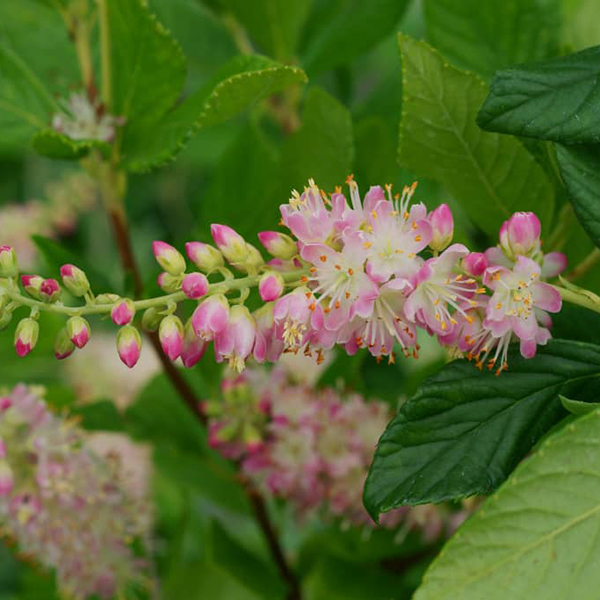
By R. Wayne Mezitt
Among my favorite summer pleasures, golfing, bicycling or walking in the woods, is experiencing the heady, honey-peppery perfume of Clethra alnifolia, commonly and aptly known as sweet pepperbush or summersweet. In bloom from late July and well into August, individual white florets open progressively along the 3-6” upright spikes (technically “racemes”), permeating the air. Clethra in the wild is often camouflaged by the forest canopy, so becoming engulfed by such a uniquely enchanting aroma can be an inspiring mystery, particularly enjoyable on those oppressively-humid midsummer days.
A densely-branched, deciduous and suckering shrub, Clethra is native to swampy woodlands and moist areas along the coast and inland from Maine to Florida. Generally maturing at 6 feet or more, its flowers attract pollinators like butterflies, bees and hummingbirds, and it is resistant to deer browsing. Late to leaf-out in spring, often waiting until May, the glossy dark green 3-4” summer leaves take on attractive shades of yellow to golden brown in autumn before dropping. Its “pepperbush” name derives from its numerous 1/8” diameter dark brown seed capsules which persist into winter.
Although it prefers moist soil conditions, Clethra and its cultivars adapt well in most local gardens (as long as the soil doesn’t dry out), full sun or partial shade, even tolerating roadside and seaside conditions. Because it forms flowers on new growth, it can be cut-back most anytime, ideally in late fall or early spring, without sacrificing bloom. The species and many cultivars tend to be stoloniferous –spreading by underground stems – especially in moist locations, and this can be a benefit as they are easily maintained in your garden.
In addition to the species, several recent Clethra alnifolia cultivars offer features compatible for many gardens. ‘Paniculata’ is similar in most aspect to the species, but with larger and more abundant flowers. The cultivar ‘Vanilla Spice’ grows to about six feet tall and 3-5 feet wide, featuring large, very fragrant flowers. . ‘Ruby Spice’ is a Cary Award winning selection (see Ruby Spice Summersweet), reaching 5-6 feet high and wide with fragrant, rosy-pink flowers, the darkest yet available.
Several more compact-growing cultivars are especially suitable for smaller gardens. ‘Hummingbird’ matures at about 3 feet high and wide and blooms more profusely than the species. Heavy-flowering with stiff upright flower racemes, ‘Sixteen Candles’ grows in a compact mound shape half the size of the species, with dark green leaves and less tendency to spread underground. Even more compact, ‘Sugartina’ grows to less than three feet high, and wider than high. Try some of these cultivars and bring the fragrant enjoyment of “summer-in-the forest” into your own yard!
About the Author
Wayne Mezitt is a 3rd generation nurseryman, a Massachusetts Certified Horticulturist, now chairman of Weston Nurseries of Hopkinton, Chelmsford & Hingham MA, and owner of “Hort-Sense”, a horticultural advisory business. He currently serves in various capacities on several horticulturally-related organizations, including the Massachusetts Horticultural Society at The Gardens at Elm Bank in Wellesley MA, and chairman for the Massachusetts Invasive Plant Advisory Group (MIPAG).









